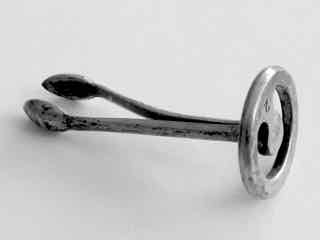Kontrazeption |
||
Spreizpessar n. HOLLWEG |
||
Der retroflektierte Uterus Die Idee, die retroflektierte Gebärmutter mittels Elfenbein-Pessar nach vorne zu heben, geht auf den Franzosen Jean Zuléma AMUSSAT (1796-1856) zurück, der 1827 solche Pessare einführte: "Intra-uterine Pessaries. The first conception of these instruments has not yet been assigned to its real author, and when, in the discussion of 1849, M. Velpeau laid claim to the priority of invention, I was surprised (says M. Depaul) that another voice was not raised to claim it. Perhaps the eminent professor of the faculty, M. Amussat, did not think the innovation a matter reflecting much credit on him. It is to be hoped that he will now give his reasons for abandoning this plan of treatment. M. Quetier, in his thesis in 1828 on retroversion of the uterus, says “M. Amussat has several times used a means which has perfectly succeeded; it consists in introducing a small ivory stem into the cavity of the uterus; but it cannot be done, he says, but with the greatest caution, and should not be practised till after the sensibility of the cavity has been destroyed by previously introducing a sound of gum-elastic. This procedure has the advantage of rendering impossible the retroversion of the uterus, as happens with the ordinary pessaries, which merely elevate the cervix, while the intestinal folds, by their pressure, cause the uterus to bend back again. Before giving this plan our entire confidence, it is better to wait till it is sanctioned by farther experience; for there is reason to fear that it may bring on acute inflammation of the uterine cavity.” After this, M. Quetier reports a case from the leçons orales of M. Amussat in 1827. Thus, there can be no doubt that M. Amussat has the first claim to the invention of the treatment of displacements by intra-uterine pessaries; and all that has since then been done, has merely been the development of his idea, and the improvement of his instrument. M. Velpeau’s intra-uterine pessary, which he seldom used, now twenty years ago, was somewhat different from Amussat's. It was not till much later that the pessaries of Kiwisch and Simpson appeared. The latter has described several instruments. Valleix supports the use of the pessary with a pubic branch externally. Rigby has made some modifications in the instrument. The chief modification in the instrument is by Valleix, who has shortened the intrauterine stem" (The Edinburg medical and surgical Journal, 1854 S.607). Das kontrazeptive Pessar "By the time the late 19th century rolled around, pessaries evolved to include metal cervico-uterine models. Physician Carl Hollweg patented a wishbone pessary in 1902 designed to “support the uterus”, and specifically, “prevent excessive and abnormal bending of this organ and to obviate and break apart any abnormal growth of tissue. Considering Hollweg’s description, it seems birth control was an unintended gain from this pessary. During the cervico-uterine heyday, the most well known wishbone spring-stem pessary in the United States was the Ideal, also known as the brooch, the butterfly, or the wishbone stem" (cit. UT Health San Antonio).
"In 1902 a Dr. Hollweg of Magdeburg faced criminal charges for five counts of negligence causing actual bodily harm for inserting stem pessaries for purposes of contraception. He defended himself by claiming to have inserted 700 other such devices without mishap" (zit. Woyke, Birth Control in Germany. 1988. S.42-3).
"Im Gegensatz zu allen anderen Pessartypen, die entweder den Gebärmuttermund und =hals oder aber das ganze hintere Scheingewölbe abdichten sollen, um durch diese mechanische Sperre ein Zusammentreffen des männlichen Samens mit dem befruchtungsfähigen weiblichen Ei zu verhüten, halten die Spreizfedern des Uterin=Pessars durch elastischen Druck die Uteruswände soweit auseinander, daß sich das Ei erst gar nicht festsetzen kann. Zugleich geben sie dem Pessar einen sicheren Sitz, ein Herausgleiten ist unmöglich" (https://bib.muvs.org/lib/uterin-spreizpessar--51580).
Exponat Spreiz-Pessar des Magdeburg-Sudenburger Arztes Carl HOLLWEG von 1901. Da die Anwendung des Pessars mit hohen gesundheitlichen Risiken verbunden war, wurde der Gebrauch ärztlich nicht empfohlen. Schon während der Retroflexio-Therapie war diese üble Komplikation bekanntgeworden: "I have seen much benefit from the application of mechanics to treat uterine displacements. But, I have seen cases in which stem pessaries have produced very serious results such as metro-peritonitis” (Sims, 1869). A splendid example of Chamber’s classic form, signed Penn - 2 - Plated (silver). VFC. Penn Surgical Manufacturing Co., Inc., Philadelphia, PA, est. 1899".
Zur Technik: um das Pessar einzuführen, verklebte der Arzt beide "Fühler des Schmetterlings" mit einem Stückchen Wachs: "A piece of wax held the two prongs together while the pessary was being inserted and when the woman’s body heat melted the wax the prongs came apart and held the device in place" (Megan Hick, Linda Adair, The Story of Contraception, 1995). Hielt Wachs dem doch erheblichen Druck nicht Stand, setzte man eine halbe Gelatinekapsel auf die "Fühler", bevor man sie einführte. Nach ein paar Stunden war diese aufgelöst, woraufhin sich die Fühler auseinanderspreizen konnten.
Da man dieses Pessar unbegrenzt in situ lassen konnte, war es unentwegt dem sauren Inhalt der Scheide und den aggressiven Ausflüssen aus dem Cavum uteri ausgesetzt. Es wurde daher aus besonders haltbarem Material, aus 800er Silber hergestellt.
Herkunft: Milo, Maine, United States. Fabrikat des US-Herstellers Chamber.
|




